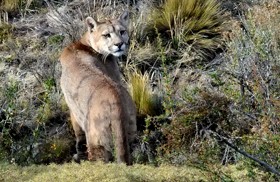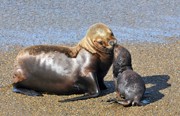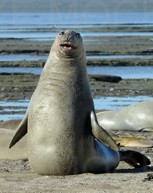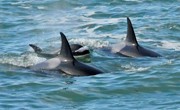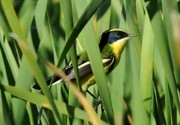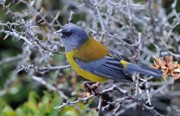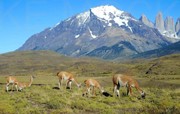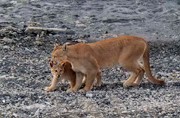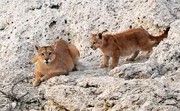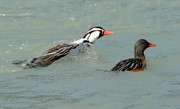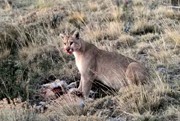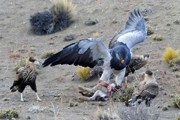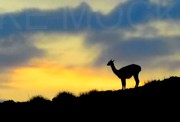FROM PENGUINS TO PUMAS …... AND THEN YET MORE PUMAS In February 2011, Mike explored Patagonia for the first time and was impressed by what he saw, especially Torres del Paine National Park in Chile. Recently, he returned to lead his first Patagonia group. The first three days of the tour were spent on the Valdes Peninsula, renowned for its Orcas that sometimes launch themselves onto the shingle beaches as they attempt to catch Sea-lion pups. In fact, although Mike’s group saw some Orcas, they weren’t doing anything nearly as spectacular as that but there were lively colonies of Southern Sea-Lions, Southern Elephant Seals and Magellanic Penguins to enjoy. One Elephant Seal colony provided great entertainment as the group sat quietly with these impressive creatures. It was a marvellous experience. The sounds made by the Elephant Seals were extraordinary - a symphony of gurgling, moaning, bleating, belching and breaking wind. Most of the wildlife on the Valdes Peninsula is around the coastline but, because Valdes is so vast, a considerable amount of driving is required to reach the small handful of places where the public is able - for that read “permitted” - to view the marine wildlife. The problem is that, in recent years, the short-sighted Valdes Park authority has turned several locations that were formerly available for wildlife-viewing into “no-go” areas. So now there is no choice: you have to drive for long periods. And it’s not as if the scenery is very inspiring: Valdes is a flat expanse of apparently barren scrubland and grassland, so these road journeys can be tedious. Of course, there are birds, even away from the coastline, but the number of species is small and many are dull in colour. Elegant-crested Tinamou, Darwin’s Nothura, Dark-bellied Shrike-Tyrant and Scale-throated Earthcreeper were all seen, along with feisty Burrowing Owls scowling back from fence posts, roosting Black-crowned Night-Herons and hunting Cinereous Harriers. Only a flock of gorgeous Tawny-throated Dotterels and the dazzling little Many-coloured Rush-Tyrant provided a splash of colour. Land mammals included Maras, looking like pointy-eared Hares on steroids and apparently wearing French waitress-style miniskirts, two species of Armadillo and the tiny, turbo-charged Lesser Cavy which moved so fast it was difficult to see, let alone photograph. Most amusing of all were Hog-nosed Skunks, including one which stumbled and fell down its own burrow. * * * * * * * * * After leaving Valdes, the group moved on to El Calafate where there were plenty of waterfowl including Coscoroba Swan, Black-necked Swan, Andean Ruddy Duck, Lake Duck, Yellow-billed Pintail, Red Shoveler and Upland Goose. Other bird highlights included the burly Magellanic Woodpecker, colourful Grey-hooded Sierra-Finches and a Black-chested Buzzard-Eagle surrounded by Southern Crested Caracaras as it fed on a European Hare. At the Perito Moreno Glacier, the weather was ideal: a comfortable temperature and diffused sunlight which was perfect for photography. Situated in Los Glaciares, one of Argentina’s most famous National Parks, the Glacier is impressive. Sadly, the National Park authority has constructed huge swathes of ugly, metal walkways, devastating an entire forested hillside. And they don’t allow anyone to stroll even a few metres from the road for some birdwatching. Very strange priorities! Especially inside a national park. * * * * * * * * * As anticipated, it was the outrageously scenic Torres del Paine National Park that really knocked everyone sideways - and that’s not a reference to the ferocious winds that battered the group on a few occasions! Extraordinary lenticular clouds, looking like flying saucers, often enhanced the scenes. Almost as otherworldly were the wonderful sunrises and sunsets. One jaw-dropping sunset made the “torres”, or “towers”, on the mountain look as if they were ablaze. Ubiquitous Guanacos complemented the landscape, posing perfectly for photographs on rocks and ridges. One even thoughtfully positioned itself on a skyline so that it was pleasingly silhouetted against a colourful sunset sky. Two species of fox, Colpeo Red Fox and Argentine Grey Fox, put in regular appearances. A few individuals that have become habituated to people around human habitation obligingly presented themselves for photographs. There were good sightings of birds such as Magellanic Horned Owl, Plumbeous Rail, Chilean Flicker, Long-tailed Meadow-Lark, Thorn-tailed Rayadito and the delightful Tufted Tit-Tyrant. Various lakes and pools held Chilean Flamingo, Great Grebe, Silvery Grebe, White-tufted Grebe, the richly coloured Cinnamon Teal and a family of Flying Steamer-Ducks. The magnificent Andean Condor was often seen too and photographers in the group had excellent opportunities for flight shots. However, of all the birds, pride of place must go to the irrepressible Torrent Duck. Indeed, is there a duck anywhere in the world with more character? The group was treated to superb views of a pair of Torrent Ducks at point-blank range as the two birds battled heroically upstream against a racing, surging current. Condors and Torrent Ducks notwithstanding, the star attractions of Torres del Paine National Park are the Pumas – assuming, of course, that you’re lucky enough to find one! Mike’s group was lucky, with no fewer than five Puma sightings! The first Puma encounter was with a mother and small cub, both slightly shy, who provided good views against a dramatic backdrop of a lake with its surface being whipped up into white horses by the wind. The next two sightings involved two females. The first of these was quite brief but the second was very special indeed. It began when the Puma was found lying a short distance from the road in the pre-dawn darkness. As the group waited for dawn, they watched her yawning and stretching. Mike noticed a faint pink stain around her face so he guessed that she had been feeding on a kill somewhere not too far away. Little did he know how close that kill was! Eventually, she walked a short distance and resumed feeding on her kill – which was just a few paces from the group’s vehicle! The unfortunate victim was a young Guanaco, known locally as a Chulengo. To watch her feeding, totally relaxed, for quite a long time was an incredible privilege. Eventually, when she had eaten enough, she set off to where she would rest for the day and soon disappeared behind a ridge, with the mountain beyond bathed in the golden light of sunrise. What a setting! What an experience! The group’s fourth Puma encounter came when the mother and cub were found again three days after the first sighting. They were still wary but everyone in the group was able to watch and photograph them by the lake shore. Finally, on the last afternoon, a handsome male Puma was discovered resting on a rocky cliff. When the sun became too warm for him, he went inside a small cave but was still clearly visible. A year ago, Mike had watched this male Puma in the same cave, accompanied on that occasion by a young female. Alone this time, he looked quite majestic as he surveyed his territory below. An appropriate end to an unforgettable tour! More images from this tour can be found in Photographic Gallery> South/Central America>Patagonia
|
|
